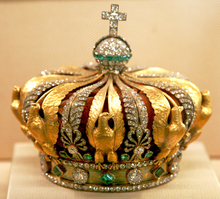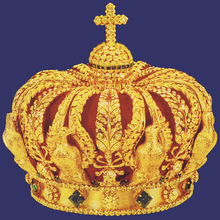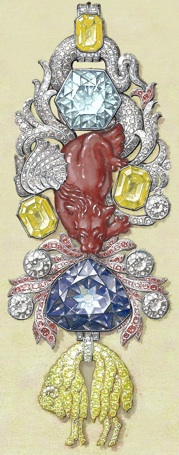French Crown Jewels
This article needs additional citations for verification. (August 2007) |


The French Crown Jewels (French: Joyaux de la Couronne de France) and Regalia comprise the crowns, orb, sceptres, diadems and jewels that were symbols of Royal or Imperial power between 752 and 1870. These were worn by many Kings and Queens of France as well as Emperor Napoleon. The set was finally broken up, with most of it sold off in 1885 by the Third Republic. The surviving French Crown Jewels, principally a set of historic crowns, diadems and parures, are mainly on display in the Galerie d'Apollon of the Louvre, France's premier museum and former royal palace, together with the Regent Diamond, the Sancy Diamond and the 105-carat (21.0 g) Côte-de-Bretagne red spinel, carved into the form of a dragon. In addition, some gemstones and jewels (including the Emerald of Saint Louis, the Ruspoli sapphire and the diamond pins of Queen Marie Antoinette) are on display in the Treasury vault of the Mineralogy gallery in the National Museum of Natural History.
Use of the French crown jewels


The Crown jewels comprise the instruments of the coronation, called the Regalia, and the jewels of the ruling family.
Since
The Crown Jewels or Diamants de la Couronne de France, consisting of gemstones and jewellery,
The
Regalia and jewels at the Louvre
Crown of Louis XV

Of about 20 documented royal crowns of the
Since the Middle Ages, and previous to the making of this crown, the crowns of French kings were adorned with gemstones like on the
Crown of Napoleon I
The
Crown of Empress Eugénie


The crown of Empress Eugénie[13] was created in 1855 by Gabriel Lemonnier for the World's fair, like the one of the Emperor which was destroyed in 1887. But Napoleon III finally chose not to be crowned.[14] Her diadem[15] by the same jeweller is on display in the Louvre with a large diamond brooch[16] by Alfred Bapst bearing two big Mazarin stones, as well as a large corsage diamond knot[17] and a pearl and diamond shoulder brooch,[18] both by François Kramer.
Coronation sword

The sword used during the coronation of the kings of France is displayed at the Louvre museum with its 13th-century scabbard,[19] apart from the crown jewels. In the first part of the celebration, the king received the insignia of knighthood, consisting of spurs and the sword. Throughout the rest of the ceremony, the sword was entrusted to the "Connétable", who held it with the blade pointing upwards. The treasury of Saint-Denis possessed several medieval swords including the one of Saint Louis. According to legend the coronation sword is "Joyeuse", [42] Charlemagne's sword.[20] Its unusual build and ornamentation makes it difficult to date, but the parts probably date back from the 10th to 13th centuries. Some believe it might be much older, even manufactured before Charlemagne's reign.
The coronation swords of
Coronation spurs
Some elements of the 12th to 16th centuries spurs were partially replaced for the coronation of
Sceptre of Charles V

One of the few surviving pieces of the medieval French crown jewels is the sceptre that Charles V had made for the future coronation of his son, Charles VI, currently on display in the Louvre.[22] It is over five feet long, and at the top is a lily supporting a small statuette of Charlemagne.[23] This evocation of Charlemagne may also explain why this sceptre was included in the imperial regalia of Napoleon I.[24]
The sceptre of Dagobert I was stolen in 1795 during the Revolution.
Main de Justice (Hand of Justice)

A typically French type of sceptre is the Main de Justice (Hand of Justice), which has as its
Another sceptre, the Baton of Guillaume de Roquemont,[27] and the ring of Saint Louis[28] are at the Louvre.
Brooch of Saint Louis
The collection keeps as well the 14th-century brooch or fermail said of Saint Louis, a large diamond shaped fibula bearing a fleur-de-lis in precious stones, which was used to hold the coronation's robe.[29]
Serpentine paten
The serpentine
Famous diamonds


Among the most famous diamonds
With two remaining jewels of the
Gemstones in the Natural History Museum and École des Mines
Some gemstones and jewels are on display in the Treasury vault of the Mineralogy gallery in the
Regalia in the National Library of France
The
Charles X regalia in Saint Denis


Some of the sovereign's robes of the coronation of
Liturgical instruments and robes in Reims

The
Theft of the crown jewels during the Revolution



The Crown Jewels were stolen in 1792 when the Garde Meuble (Royal Treasury) was stormed by rioters. Most, though not all, of the Crown Jewels were recovered eventually. Sancy Diamond was found in Russia at Vasily Rudanovsky collection. The Royal French Blue is believed to have been recut, and it is now known as the Hope Diamond.
The Hope is famously alleged to have been surrounded by bad luck. Marie Antoinette who supposedly wore it was beheaded (in fact, it was actually worn by her husband, Louis XVI, although he too was beheaded). Other owners and their families experienced suicides, marriage break-ups, bankruptcy, deaths in car crashes, falls off cliffs, revolutions, mental breakdowns, and deaths through drug overdoses. It was even tangentially associated with the case of the murdered Lindbergh baby, when its then owner, silver heiress Evalyn Walsh McLean, pawned it to raise money that she ended up paying to a con-man unconnected with the actual kidnapping. Most modern historians view the tales of a curse on the Hope to be spurious; the first mention of such tales is documented to 1908. Pierre Cartier, the Parisian jeweler, is widely credited with publicizing the stories of a curse on the diamond in hopes of increasing its saleability. Since 1958, it has been in the Smithsonian Institution in Washington, D.C., where it is the single most-viewed object in the Smithsonian's collection. [citation needed]
The Crown Jewels were augmented by jewels added by
Last coronation
The last French coronation occurred in 1825 when King
Break-up and sale of the French crown jewels

During the late 18th and 19th centuries the jewels survived the French First Republic, the Directorate, the First Empire, the Restoration, the July Monarchy, the French Second Republic and the Second Empire. However, the decision of Henri, Comte de Chambord not to accept the French Crown in the early 1870s ended not just the prospect of a royal restoration. It also led to the break-up and partial sale of the Crown Jewels. The Brazilian beauty Aimée de Heeren,[48] WW2 secret service agent for President Getúlio Vargas was known for being the largest private owner of the French Crown jewels, along with other important jewelry. The jewels were presents from Hugh Grosvenor, 2nd Duke of Westminster who bought whatever he could find between the years 1939 and 1953.
In 1875, the
While few expected a royal restoration, certainly after the failure of the Seize Mai attempted royalist coup by the Marshal Patrice de MacMahon, sitting President of the French Republic, the continuing agitation of extreme right-wing royalists, and the fear of a royalist coup d'état, led radical deputies to propose the sale of the Crown Jewels, in the hope that their dispersal would undermine the royalist cause: "Without a crown, no need for a king" in the words of one member of the National Assembly. This controversial decision was implemented. All the jewels from the Crown Jewels were removed and sold in 1887, as were many of the crowns, diadems, rings and other items. Only a few of the crowns were kept for historic reasons, but with their original diamonds and gems replaced by colored glass. Some historic or unusual gems went to French museums, including the Regent Diamond, the Hortensia diamond, and the corsage brooch containing some of the 'Mazarin diamonds', all of which now reside in the Louvre;[49] and the 'Ruspoli' sapphire, which is now in the French Natural History Museum (curators took advantage of its unusual rhombohedral faceted shape and asked for it to be exempted from the sale, falsely claiming that it was a natural, uncut crystal).
See also
References
- ^ [1] List of the surviving main Crown jewels
- ^ [2] History of the Diamants de la Couronne
- ^ [3] List of the surviving Regalia
- ^ [4] Plates of the treasure from Dom Michel Félibien, Histoire de L'Abbaye Royale de Saint-Denys en France, 1706
- ^ [5] Crown of Saint Louis in the treasure of Saint Denis in 1706, from Dom Michel Félibien, Histoire de L'Abbaye Royale de Saint-Denys en France.
- ^ [6] Crown of Saint Louis or Sainte Couronne de France.
- Saint Denis in 1706, from Dom Michel Félibien, Histoire de L'Abbaye Royale de Saint-Denys en France.
- Saint Denis in 1706, from Dom Michel Félibien, Histoire de L'Abbaye Royale de Saint-Denys en France
- Crown of Louis XV, 1722, Louvre
- ^ [10] Crown of Saint Louis.
- Napoleon I in coronation costume, François Gérard, 1805, Louvre
- Napoleon I, 1804, Louvre
- ^ [13] Crown of Empress Eugénie, 1855, Louvre
- ^ [14] Portrait of Napoleon III with his crown, ca 1855, Louvre
- ^ [15] Diadem of Empress Eugenie, 1853, Louvre
- ^ [16] Large diamond brooch « rocaille » of Empress Eugenie, 1855, Louvre
- ^ [17] Large corsage diamond knot of Empress Eugenie, 1855, Louvre
- ^ [18] Archived 2015-05-28 at the Wayback Machine Pearl and diamond shoulder brooch of Empress Eugenie, 1853, Louvre
- ^ [19] King's sword scabbard, 13th century, Louvre
- ^ [20] Coronation sword, 10th to 13th centuries, Louvre
- ^ [21] Coronation spurs, 12th to 16th centuries and 1804, Louvre
- ^ [22] Sceptre of Charles V, 14th century, Louvre
- ^ "HIST 608 Monarchs in Europe". Archived from the original on 2012-08-05. Retrieved 2009-08-24. Sceptre of Charles V
- ^ File:Ingres, Napoleon on his Imperial throne.jpg
- ^ [23] Hand of Justice, 1804 and medieval, Louvre
- Saint Denis, 12th century, Louvre
- ^ [25] Baton of Guillaume de Roquemont, 14th century, Louvre
- ^ [26] Ring of Saint Louis, 14th century, Louvre
- ^ [27] Brooch (fermail) of Saint Louis, 14th century, Louvre
- ^ [28] Serpentine paten, 1st century BC or AD and 9th century, Louvre
- ^ [29] The Diamants de la Couronne
- ^ [30] Regent Diamond, Louvre
- Empress Marie Louise, Louvre
- Empress Marie Louise, Louvre
- Duchess of Angoulême, Louvre
- Duchess of Angoulême, Louvre
- Queen Marie Amélie, Louvre
- ^ [36] List of the surviving main Crown jewels
- ^ [37] The jewels in the Apollo gallery, Louvre
- ^ "Emeraude de Saint Louis - St Louis Emerald". CRPG: Le Centre de Recherches Pétrographiques et Géochimiques. Retrieved 8 February 2017.
- Museum national d'histoire naturelle
- ^ Cup of the Ptolemies, "the most precious vase that is in the treasure of Saint-Denis, and perhaps in any European cabinet." (Michel Félibien, Histoire de... Saint-Denys, Paris, 1706, pl. vi, at full scale); "one of the greatest treasures in the Cabinet des Médailles" (Sir W. Martin Conway, 1915, pp 119f (on-line)); etc.
- Basilica of St Denis
- ^ Regalia in Saint-Denis, base POP.
- ^ [39] Reliquary of Charles X for the Holy Ampulla
- ^ [40] Ampulla and needle of the reliquary of Charles X
- ^ [41] Content of the Holy Ampulla kept in Reims archbishopric.
- ^ Aimée de Heeren, later owner of the private jewelry of Empress Eugenie
- ^ "Site officiel du musée du Louvre". cartelfr.louvre.fr. Retrieved 2020-08-07.
